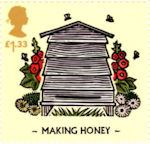Bees
Bees are our unacknowledged partners and ancient allies, vital in the pollination of food crops, keeping farms in business and in helping parks, gardens and the countryside to thrive. Yet bees are in decline in their numbers and their range. The plight of bees is in the press every week and this stamp issue is to educate as to the huge variety of British bees, their vital importance and to promote a protective feeling among customers and mail senders and receivers.2015 (August 18 2015)
Commemorative
Designed by Anna Ekelund
Size 37mm (h) x 35mm (v)
Printed by International Security Printers
Print Process Lithography
Gum PVA
Bees , Vol.52 No.11 (Issue Details)
Stamps
Scabious Bee (Andrena hattorfiana)
2ndImage preview by Royal Mail
Shown on Field Scabious Knautia arvensis One of the largest solitary bees and a ‘mining bee’. Has declined in range but today South West England is key area. Other populations in East Anglia and South Wales. Lives in sandy or open grassland, and the plant field scabious is essential, as its pollen is used to feed the young larvae. This reinforces the connection between insect and plant, and the interdependence. If populations of one falls, the other suffers decline.
Great Yellow Bumblebee (Bombus distinguendus)
1stImage preview by Royal Mail
Shown on Bird’s-foot Trefoil (Lotus corniculatus) A flagship conservation species for Scotland and at extreme of range now (thought to have declined from 80% of its historic range in the UK). Forages in grassland on clover, vetch and knapweed.
Northern Colletes Bee (Colletes floralis)
£1.00Image preview by Royal Mail
Shown on Wild Carrot (Daucus carota) Recorded in Northern Ireland in 2003 for the first time in 70 years. UK and Irish population represent 50% of global total, so very important. Prefers sandy/coastal environment and forages on range of flowers including carrot and parsley family.
Bilberry Bumblebee (Bombus monticola)
£1.33Image preview by Royal Mail
Shown on Bilberry (Vaccinium myrtillus) Concentrated in NE England but also in Wales and SW England. Higher altitude habitats. Forages on bilberry as well as bramble, raspberry, bell heather, sallow and legumes such as clover and bird’s foot trefoil (hence vital in pollinating nitrogen-fixing plants in agriculture).
Large Mason Bee (Osmia xanthomelana)
£1.52Image preview by Royal Mail
Shown on Horseshoe Vetch (Hippocrepis comosa) Britain’s rarest solitary bee and now found only at two sites in Wales. Females collect fresh water from cliffs and use to make mud in the building of nest cells. Forage nectar from horse shoe vetch, bramble and bugle.
Potter Flower Bee (Anthophora retusa)
£2.25Image preview by Royal Mail
Shown on Ground Ivy (Glechoma hederacea) Has declined severely and found in few sites in SE England. A ‘flower bee’ that has appearance of a bumble bee but is solitary. Has a preference for sandy soils such as dunes, cliffs and commons. Forages from ground ivy, vetches, clovers, bird’s foot trefoil.
PHQ Cards
RM Code AQ225


































